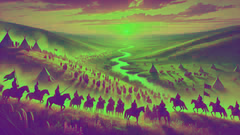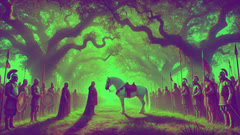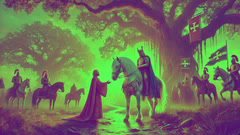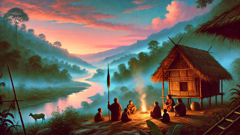Introduction
In the rolling heart of medieval Europe, where the sun-drenched grasslands stretched into endless horizons and the blue rivers meandered quietly between dense forests, a legend was born—one that would shape the destiny of a nation and echo through the centuries. The Carpathian Basin, wild and untamed, had long been a crossroads for wandering tribes and mighty peoples, each leaving their footprints on the fertile soil. But none would leave a mark as indelible as the Magyars, led by the visionary chieftain Arpad. Their journey was more than a migration; it was a test of cunning, courage, and wisdom, a tale woven with ambition and hope. At its heart was a white horse, as luminous as the morning mist, whose fate would become forever entwined with the land. In these ancient times, borders were drawn not just by sword or treaty, but by the sharper blade of wit. The Magyars, fierce horsemen from the eastern steppes, were seeking a new home—a land to nurture their children and their dreams. The Carpathian Basin, with its rivers and meadows, forests and hills, beckoned like a promised paradise. Yet it was not empty; it was the domain of Slavic princes, most notably Szvatopluk, whose rule was as firm as the mountains themselves. What unfolded was no ordinary conquest. Instead, it was a contest of minds, a bargain spun from clever words and ancient customs. Through the hush of dawn, as mist clung to the reeds and herons rose over the marshes, emissaries from both peoples met beneath the boughs of mighty oaks. There, a white stallion—proud, spirited, flawless—would become the currency of destiny. In exchange for this noble steed, Arpad asked not for bloodshed or war, but for the right to settle, a transaction sealed with a saddle and bridle. But beneath the surface of this simple trade simmered strategy and foresight, for what seemed a modest offering would unfold as a masterstroke of cunning. The legend of the white horse is not merely a story of acquisition, but of wisdom triumphing over force, of a leader who understood that sometimes the sharpest arrow is a clever mind. The tale has endured in the heart of Hungary for generations, told by firelight and sung in ancient ballads. It is a story of beginnings: of a people’s journey, a leader’s brilliance, and the promise of a new homeland shaped by courage, shrewdness, and the dazzling flash of a white horse’s mane.
The Magyars’ Arrival: Dreams and Dilemmas
The road from the steppes to the Carpathian Basin had been long and perilous, marked by hardship, hope, and the undying spirit of a people in search of their future. For years, the Magyars had roamed the windswept plains of the east—nomads whose lives were intertwined with their horses, whose children learned to ride before they could walk, and whose stories danced with dreams of greener pastures. The open steppe was freedom and home, but the pressure of hostile neighbors and changing fortunes pushed them westward, ever seeking a place of abundance and safety. Their journey was a saga in itself: rivers forded in spring floods, mountains crossed beneath starlit skies, the constant threat of rival tribes at their heels. But the Magyars were not easily broken. They carried with them ancient customs, the wisdom of elders, and a unity forged in adversity. At their head rode Arpad, a leader chosen not merely for his valor in battle but for his keen mind and the trust he inspired. He listened to his people, weighed risks with careful eyes, and saw farther than most—a man born for times of change.

When at last the Magyars reached the fringe of the Carpathian Basin, their hearts beat with awe and longing. Before them stretched a land rich beyond imagining: meadows rippling in the wind, forests bursting with game, rivers teeming with fish. Wildflowers blazed in color, and the air tasted of possibility. Here, surely, was the end of wandering—a cradle for a nation. Yet the land was not unclaimed. Villages dotted the hills, fields bore the marks of tilling, and smoke curled from the homes of Slavic settlers. These people had their own chieftain, Szvatopluk, whose influence reached far across the region. The Magyars set up camp on the plain, careful to show respect but ready to defend themselves. Tension shimmered in the air as scouts from both sides watched each other with wary eyes.
The first encounters were measured and cautious. Arpad, wise to the ways of diplomacy, sent envoys bearing gifts and words of peace. The Magyars’ arrival could have sparked war, but Arpad knew that swords drawn in haste often led to ruin. Instead, he sought parley, inviting Szvatopluk’s emissaries to feast beneath white pavilions, where lamb roasted over fires and wine flowed like the rivers. Around the firelight, stories were shared and customs exchanged—a dance of curiosity and guarded goodwill.
It was during these gatherings that Arpad’s mind began to work in earnest. He saw that Szvatopluk was proud but also practical; he valued wealth, horses, and tokens of power. Rumors swirled among the Magyars about the prince’s taste for rare animals and fine trappings. Among Arpad’s own herd was a horse unlike any other: a stallion as white as new snow, swift as the river’s current, with a mane that glistened like silk in the dawn. To the Magyars, such a horse was more than a beast—it was a symbol of freedom, nobility, and the favor of the gods.
As days passed, the mood in camp grew restless. Some Magyars argued for conquest, others for patience. Arpad called his closest advisors to council. They gathered beneath the ancient trees, voices low, as he laid out his vision. “If we take this land by force,” Arpad reasoned, “we may win today but lose tomorrow. Let us use wisdom as our weapon. Let us offer that which cannot be refused—and claim more than any sword could win.”
The Bargain of the White Horse: Wit Versus Power
When the day came for formal negotiations, anticipation crackled through both camps. Beneath the broad canopies of ancient oaks at the river’s bend, banners fluttered in the breeze. On one side stood Arpad and his trusted companions—warriors clad in leather and fur, their brows marked by wind and sun. On the other stood Szvatopluk’s retinue: Slavic nobles in embroidered tunics, their eyes guarded but curious. Between them, a space was cleared and draped with fine carpets, a neutral ground for words to take flight.

Szvatopluk was a man accustomed to command, his presence as imposing as the mountain peaks. He listened as Arpad’s envoys presented their petition: the Magyars wished to settle in the land, to become neighbors rather than conquerors. At first, Szvatopluk regarded the request as presumptuous. Why should he cede fertile fields to strangers—however well-mannered or formidable? Yet Arpad’s reputation had preceded him, and the Magyar gifts—honey, furs, and hand-crafted bows—spoke of wealth and skill. The prince’s interest was piqued, but not yet convinced.
Then Arpad unveiled his masterstroke. With a flourish, his men led forth the white stallion: a creature of breathtaking beauty, its coat gleaming like polished ivory beneath the sun. The animal’s eyes were intelligent and proud, its movements fluid as water. Arpad presented not only the horse, but also a saddle and bridle of exquisite workmanship, adorned with silver and intricate patterns that told stories of the steppe. “Let this be our tribute,” Arpad declared. “A gift worthy of a prince. In exchange, grant us as much land as may be encompassed by the hide of this horse.”
At this, Szvatopluk and his nobles exchanged glances. To them, it seemed a paltry price for land—an animal, no matter how fine, for broad swathes of territory. But the prince, ever hungry for prestige and fine possessions, agreed with a sly smile. The agreement was sealed before witnesses from both tribes. The white horse trotted to Szvatopluk’s side, its mane rippling in the wind—a vision of triumph for the prince.
But Arpad was not finished. That night, as Magyar fires flickered beneath the stars, his advisors set to work. They took the hide of another great ox and, with sharp knives and patient hands, cut it into a single, unbroken strip—so thin it seemed spun from silk. By dawn, they had a ribbon of hide long enough to encircle an entire valley. When the moment came to mark out the land, Arpad stretched the strip in a wide loop across the meadow and hills, encompassing fields, forests, and riverbanks far beyond what Szvatopluk had imagined.
Szvatopluk’s retinue cried foul, but Arpad only smiled and pointed to the terms of their bargain: as much land as could be encompassed by the hide of the white horse. The prince realized he had been outwitted, but honor demanded he abide by his word. The deal stood. The Magyars had won not just a foothold, but a kingdom’s worth of earth—a homeland gained not by bloodshed, but by brilliance. In the years to come, this moment would be remembered not as trickery but as proof of Arpad’s genius and wisdom.
Conclusion
Thus, with a single white horse and the clever turn of a phrase, Arpad set in motion the founding legend of Hungary. The Magyars took root in the Carpathian Basin, their destiny intertwined with the land they had claimed by wit and not by war. The story of the white horse became a cornerstone of Hungarian identity—a reminder that wisdom can achieve what strength alone cannot. Through fields sown with wheat and towns built along winding rivers, generations would tell and retell how their ancestors earned a home with shrewdness and vision. Even today, when the sun rises over the Hungarian plains and horses gallop across the open meadows, echoes of Arpad’s triumph ride on the wind—a tribute to the power of cunning, unity, and belief in one’s people.













